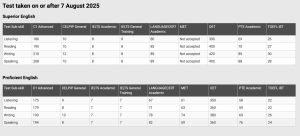Thinking about a big change? A skilled visa for Australia might be your ticket to a new life. These visas are designed to attract talented professionals to fill critical skill shortages across the country, and they offer a host of benefits that go far beyond just a job.
So, why are so many people seeking a skilled visa for Australia? Let’s break down the incredible advantages.
1. A Pathway to Permanent Residency and Citizenship
Perhaps the biggest challenge of a skilled visa is that it’s a direct path to building a permanent life in Australia. Unlike temporary work visas that have a limited duration of stay, many skilled visas—like the Skilled Independent visa (subclass 189) and the Skilled Nominated visa (subclass 190)—are permanent visas. This means you can live, work, and study in Australia with no time limit.
After a certain period of time as a permanent resident, you can become eligible to apply for Australian citizenship, which opens up even more opportunities, including the right to an Australian passport and the ability to vote.
2. Live and Work Anywhere You Choose
For those who secure a permanent skilled visa without state nomination (like the subclass 189), you have the freedom to live and work anywhere in Australia. This gives you the flexibility to choose a city or region that best suits your lifestyle and career goals, whether that’s the bustling metro of Sydney and Melbourne or a more relaxed regional area.
Even if you are nominated by a state or territory (subclass 190 or 491), you’ll gain the freedom to live and work across that state or in a designated regional area, with a clear pathway to permanent residency.
3. Access to World-Class Healthcare and Social Security
As a permanent resident, you and your family gain access to Medicare, Australia’s universal healthcare system. This provides free or subsidized access to public hospitals, doctors, and a wide range of medical services. This peace of mind is invaluable.
In addition, skilled visa holders may be eligible for social security benefits from the government’s Centrelink program, which can provide a safety net in times of need.
4. Educational Opportunities for the Whole Family
Permanent residents are entitled to enroll their children in Australia’s public primary and secondary schools at no cost. This provides your family with access to a high-quality education system and ensures your children have a smooth transition into their new life.
Furthermore, permanent residents can access financial assistance for higher education through schemes like the Higher Education Loan Program (HELP), making university and other higher education courses more affordable.
5. A Strong and Stable Economy
Australia’s economy is healthy and adaptable, with a low unemployment rate. The skilled visa program is designed to bring in workers for occupations that are in high demand, which means there are real job opportunities waiting for you. This stability allows you to plan your career and build a secure future for yourself and your family.
How Does It Work? The Points Test
Many of Australia’s skilled visas are points-tested. The Australian government uses a points system to evaluate a candidate’s suitability based on factors like:
- Age: You get points if you are between 18 and 45 years old.
- English Language Proficiency: Higher scores on English tests like the IELTS or PTE earn you more points.
- Work Experience: You can earn points for both your overseas and Australian work experience.
- Educational Qualifications: Points are awarded for your degrees, with a doctorate earning the highest score.
- Other Factors: You can also gain points for having a skilled partner, studying in a regional area, or completing a Professional Year in Australia.
The benefits of a skilled visa are immense, offering not just a job, but a complete life change in a country known for its high quality of life, stunning natural beauty, and friendly people. If you have the skills Australia needs, the dream of living here is closer than you think.




